
Rattus is a genus of muroid rodents, all typically called rats. However, the term rat can also be applied to rodent species outside of this genus.
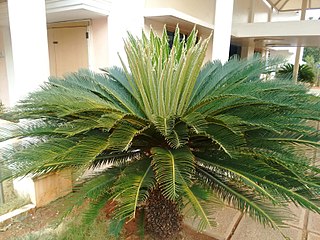
Cycas is a genus of cycad, and the only genus in the family Cycadaceae with all other genera of cycad being divided between the Stangeriaceae and Zamiaceae families. Cycas circinalis, a species endemic to India, was the first cycad species to be described in western literature, and is the type species of the genus.

Myrmarachne is a genus of ant-mimicking jumping spiders that was first described by W. S. MacLeay in 1839. They are commonly called ant-mimicking spiders, but they are not the only spiders that have this attribute. The name is a combination of Ancient Greek μύρμηξ, meaning "ant", and ἀράχνη, meaning "spider".

Dorcus is a genus of beetles in the stag beetle family Lucanidae. Of the over 100 species, most occur in Asia and India; two are found in southern Europe, and two species are from North America. Previously, specimens with serriform teeth on the mandibles and sable pigment were called Serrognathus whereas specimens with but a singular or multiple bulky notches on the mandibles and lustrous sable pigmentation were called Dorcus.
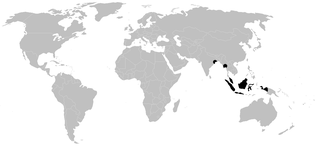
The Stylocellidae are a family of harvestmen with about 40 described species, all of which occur in Southern or Southeastern Asia. Members of this family are from one to seven millimeters long. While Stylocellus species have eyes, these are absent in the other two genera.

Mormolyce is a genus of ground beetles in the subfamily Lebiinae. They all possess distinctive violin-shaped elytra and live between layers of bracket fungi.

Syntelia is a genus of beetles. It is the only genus in the family Synteliidae. There are seven known species, which are native to high-elevation regions in southern North America from central Mexico to Guatemala, and in eastern Asia, from India to Japan and eastern Russia. They are generally associated with rotting logs, typically found under bark, though the Mexican species S. westwoodi has been found inside large decaying columnar cacti. Adults and larvae are predatory, feeding on insect larvae. A fossil species, Syntelia sunwukong, is known from the Late Cretaceous (Cenomanian) aged Burmese amber of Myanmar. Adults are around 1–3.5 centimetres (0.39–1.38 in) in length. The characteristics of the family and genus include geniculate antennae with 3-segmented club, elongate body, narrowly separated coxae and tarsi with bisetose empodia. Only one abdominal segment is exposed behind elytra. The genus described by John O. Westwood in 1864, while the family was erected by George Lewis in 1882. They are members of Histeroidea, which also includes clown beetles (Histeridae).
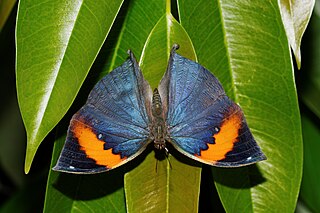
Kallima paralekta, the Indian leafwing or Malayan leafwing, is a species of brush-footed butterfly of the genus Kallima. Despite its common names, it is not found in India or Malaysia, but is endemic to Java and Sumatra in Indonesia. Like other members of its genus, it is remarkable for its strong resemblance to a dead leaf when its wings are folded. It was one of the species encountered by the British naturalist Alfred Russel Wallace in his travels in maritime Southeast Asia. It is mentioned in his famous 19th-century work The Malay Archipelago as one of the best examples of protective camouflage achieved through natural selection.
Aristolebia is a genus in the beetle family Carabidae. There are more than 20 described species in Aristolebia.

Brachichila is a genus in the beetle family Carabidae. There are about seven described species in Brachichila, in Southeast Asia.
Dhanya is a genus of in the beetle family Carabidae. There are about seven described species in Dhanya.

Cerapterus is a genus in the beetle family Carabidae. There are more than 30 described species in Cerapterus.
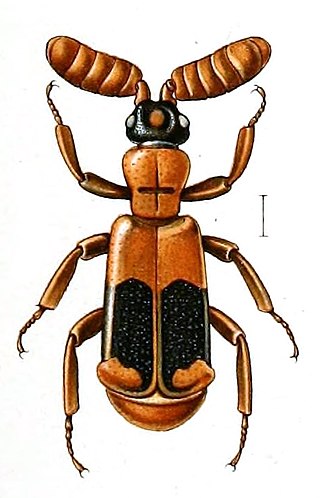
Ceratoderus is a genus in the beetle family Carabidae. There are about 11 described species in Ceratoderus.

Lebioderus is a genus in the beetle family Carabidae. There are about 11 described species in Lebioderus.
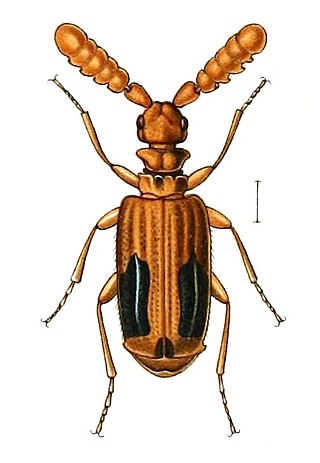
Melanospilus is a genus of flanged-bombardier beetles or paussines in the family Carabidae, containing the following species: The genus is considered to belong to the subtribe Ceratoderina and all members are thought to be myrmecophiles. The ant host Paratrechina longicornis is known for M. bensoni.
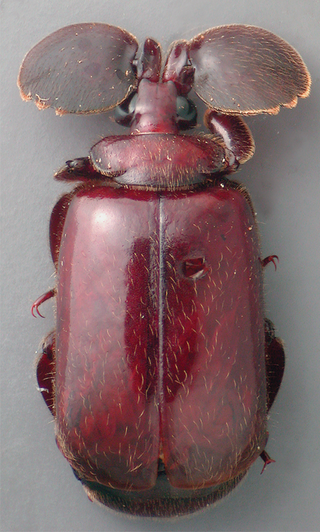
Platyrhopalopsis is a genus of flanged-bombardier beetles in the family Carabidae. They are found, as in others of the group, within ant nests, in the Indo-Malayan region. Adults are rarely seen except at lights. The flat terminal segment of the antenna is thought, based on studies of pupal development, to be formed by the fusion of multiple antennomere segments. The genus, placed by some in the tribe Platyrhopalina, includes the following three species:

Paussini is a tribe of ground beetles in the family Carabidae. There are more than 25 genera and 610 described species in Paussini. They are found mainly in Africa, southern Asia, and the Pacific, although the genus Homopterus is found in the Americas.
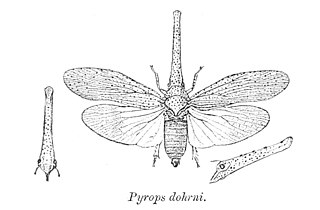
Zanna is a genus of tropical planthoppers found in Asia and Africa, now belonging to the monotypic subfamily Zanninae.
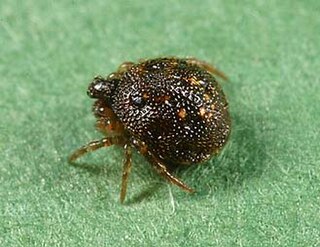
Phoroncidia is a genus of comb-footed spiders that was first described by J. O. Westwood in 1835.

Proutista is a small genus of planthoppers from the family Derbidae, tribe Zoraidini, with 10 species, as of 2024. The type species, Proutista moesta is widely distributed and often very common, its distribution ranging from Tanzania in Africa, over some Indian Ocean islands and southern parts of western Asia to far eastern Asia and parts of the western Pacific. Seven of the remaining species are also found in tropical parts of Asia and only two additional species have been recorded from Africa, where Proutista fritillaris is the most common one. The species of Proutista are characterized by a combination of different features, mainly the shape and venation of the forewings, the size of the hind wings and the structure of the head and the antennae. On the forewings the media vein has 6 branches, none of them branching further into sub branches. The hind wings are about half as long as the forewings and have a rounded tip. The head has a narrow face (frons) and the antennae are rather short, much shorter than the face.

















